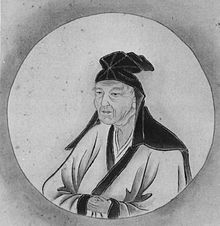Hayashi Razan
Hayashi Razan ( Japanese 林 羅山 ; * 1583 in Kyōto ; † March 7, 1657 in Edo ) was a leading exponent of neoconfucianism of the early Edo period . With him begins the story of the House of Hayashi, which produced influential Confucian scholars well into the 19th century. Razan is his author's name, his posthumous name ( imina ) is Nobukatsu ( 信 勝 ), his age- old name ( azana ) was Konobu ( 子 信 ). In the monastery he was given the name Dōshun ( 道 春 ).
Life
Hayashi was born in Kyoto in 1583 and entrusted to an uncle because of family circumstances as an adopted son. The extremely gifted child began Buddhist studies in the Kennin Temple ( Kennin-ji , 建 仁 寺 ) in 1595 , but refused permanent admission to the monk and returned to his family at the age of 15. Here he turned to the teachings of the neo-Confucian Chinese philosopher Zhu Xi (Japanese name: Shushi) and especially studied his commentaries on the " Four Canonical Books ".
In 1604 he met the philosopher Fujiwara Seika , who, out of a great dissatisfaction with Buddhism, tried to combine Shinto elements with Confucian elements and gathered scholars with similar thinking around him. This encounter had a decisive influence on Razan's further life. Seika was impressed with Razan's intellectuality. The following year he introduced the 23-year-old Razan to the first shogun and founder of the Tokugawa dynasty, Tokugawa Ieyasu in Kyoto and recommended him for an official position.
In 1606 Razan led a heated debate with Fabian Fucan (c. 1565–1621), a Japanese Jesuit, about the shape of the earth and the cosmos. 1607 Razan moved to Edo and worked as an advisor to the second Shogun Tokugawa Hidetada (Ieyasu's third son). In 1624 he was appointed teacher ( jikō , 侍講 ) to the second son of Hidetada, Tokugawa Iemitsu . Razan was involved in the establishment of the Tokugawa system of rule in a variety of ways. In 1635 he wrote the font Buke Shohatto ( 武 家 諸法 度 , dt. " Regulations for the Houses of Warriors"), the following year he made a pilgrimage to the Ise Shrine and held a ceremony there.
In 1632 he built a mausoleum in the Ueno Shinobugaoka district of Edo with the help of the daimyo Tokugawa Yoshinao of Owari, the "Palace of the Old Saint" ( 先 聖殿 , Zeseiden ; meaning Confucius ), which later became the Shōheikō ( 昌平 黌 ), the semi-state neoconfucian Should be an elite school and training center for government officials. The rectorate remained since Hayashi Hōkō ( 林 鳳 岡 ), Razan's grandson, as an inheritance at the House of Hayashi.
Razan exercised great influence in the consolidation phase of the new shogunate by drafting regulations for institutions and etiquette regulations. In addition to the "teaching of the wise" (literal translation of the term jugaku , 儒学 , dt. " Confucianism ") he wrote travel records. The compilation of Tashikihen ( 多 識 編 ), which correlates around 2000 keywords from the Chinese remedies Běncǎo Gāngmù ( Chinese 本草綱目 ) and Nóngshū with ( 農 書 ) Japanese terms, was also influential and had a great influence on Japanese doctors of the 17th century exercised.
The school direction he founded in his later years, the so-called Ritō-Shinchi-Shintō , which had the unity of Confucianism and Shintō as well as the rejection of Buddhism, formed the basis for the later flow of Confucianist Shintō ( 儒家 神道 , Juka- Shinto ).
Hayashi's tomb is located in Tokyo's Shinjuku District, Ichidani Yamabushi District .
Works (selection)
- Tashiki-hen . Print 1612 ( 多 識 篇 )
- Honchō jinja-kō . Print 1645 ( 『本 朝 神社 考』 )
- Heishin kiko . ( 『丙辰 紀行』 )
- Participation in: Kan'ei shoke keizu-den ( 『寛 永 諸 家 系 図 伝』 )
Remarks
literature
- Willem Jan Boot: The Adoption and Adaption of Neo-Confucianism in Japan. the role of Fujiwara Seika and Hayashi Razan . Lectura Leiden, Leiden 1982.
- Hans Müller: Hai-Yaso 俳 耶蘇 Anti-Jesus. Hayashi Razan's anti-Christian account of a Confucian Christian disputation from 1606 . Monumenta Nipponica , Vol. 2, No. January 1, 1939, pp. 268-275
Web links
- Yazaki Hiroyuki: "Hayashi Razan" . In: Encyclopedia of Shinto. Kokugaku-in , April 12, 2006 (English)
| personal data | |
|---|---|
| SURNAME | Hayashi Razan |
| ALTERNATIVE NAMES | 林鳳 岡 (Japanese); 林信勝 (Japanese, real name); Hayashi Nobukatsu (real name); 林道春 (Japanese); Hayashi Doshun |
| BRIEF DESCRIPTION | Confucians of the early Edo period |
| DATE OF BIRTH | 1583 |
| PLACE OF BIRTH | Kyoto |
| DATE OF DEATH | March 7, 1657 |
| Place of death | Edo |
